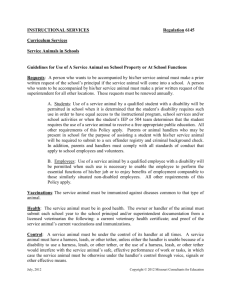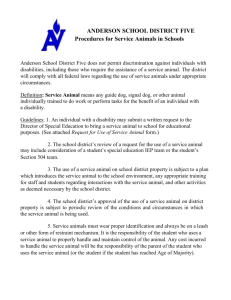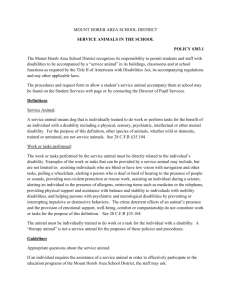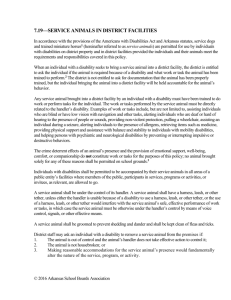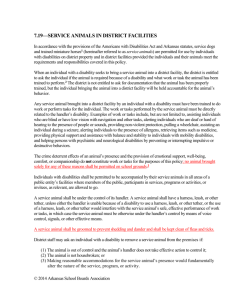Accommodating Persons with Service Animals
advertisement
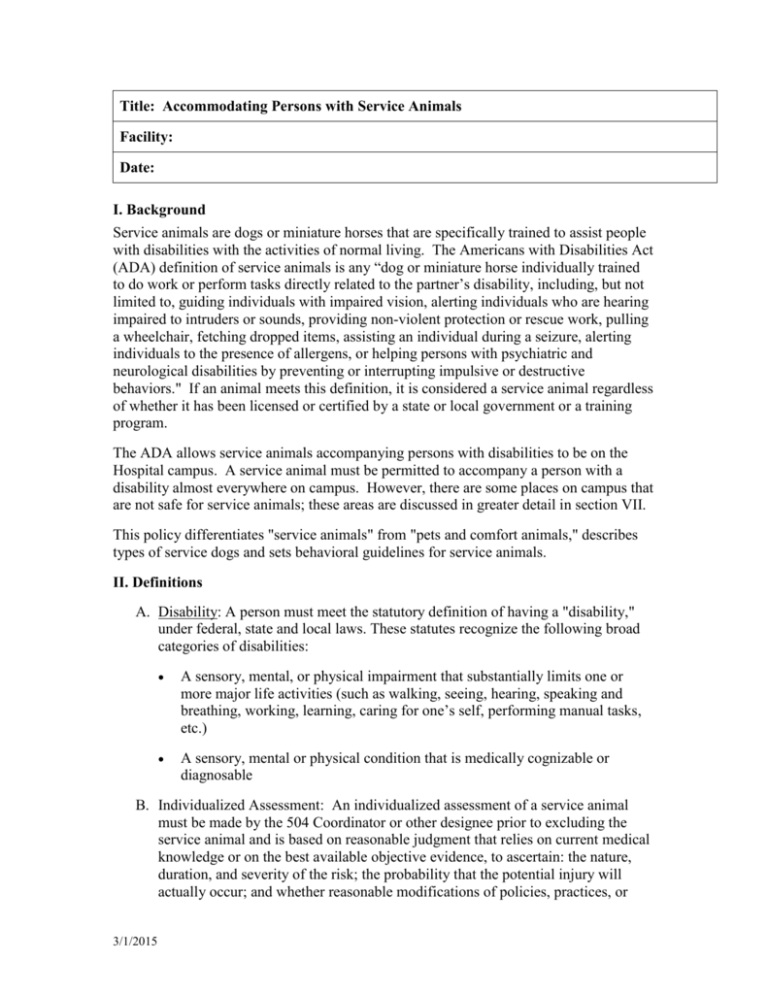
Title: Accommodating Persons with Service Animals Facility: Date: I. Background Service animals are dogs or miniature horses that are specifically trained to assist people with disabilities with the activities of normal living. The Americans with Disabilities Act (ADA) definition of service animals is any “dog or miniature horse individually trained to do work or perform tasks directly related to the partner’s disability, including, but not limited to, guiding individuals with impaired vision, alerting individuals who are hearing impaired to intruders or sounds, providing non-violent protection or rescue work, pulling a wheelchair, fetching dropped items, assisting an individual during a seizure, alerting individuals to the presence of allergens, or helping persons with psychiatric and neurological disabilities by preventing or interrupting impulsive or destructive behaviors." If an animal meets this definition, it is considered a service animal regardless of whether it has been licensed or certified by a state or local government or a training program. The ADA allows service animals accompanying persons with disabilities to be on the Hospital campus. A service animal must be permitted to accompany a person with a disability almost everywhere on campus. However, there are some places on campus that are not safe for service animals; these areas are discussed in greater detail in section VII. This policy differentiates "service animals" from "pets and comfort animals," describes types of service dogs and sets behavioral guidelines for service animals. II. Definitions A. Disability: A person must meet the statutory definition of having a "disability," under federal, state and local laws. These statutes recognize the following broad categories of disabilities: A sensory, mental, or physical impairment that substantially limits one or more major life activities (such as walking, seeing, hearing, speaking and breathing, working, learning, caring for one’s self, performing manual tasks, etc.) A sensory, mental or physical condition that is medically cognizable or diagnosable B. Individualized Assessment: An individualized assessment of a service animal must be made by the 504 Coordinator or other designee prior to excluding the service animal and is based on reasonable judgment that relies on current medical knowledge or on the best available objective evidence, to ascertain: the nature, duration, and severity of the risk; the probability that the potential injury will actually occur; and whether reasonable modifications of policies, practices, or 3/1/2015 Accommodating Persons with Service Animals procedures or the provision of auxiliary aids will mitigate the risk. 28 C.F.R §36.208(b); 28 C.F.R. §35.139(b) C. Partner/Handler: A person with a service or therapy animal. A person with a disability is called a partner whereas a person without a disability is called a handler. D. Pet/Comfort Animal: A domestic animal kept for pleasure or companionship. Pets are not permitted in the Hospital. Permission may be granted by Administration for a pet to be in a campus facility for a specific reason at a specific time. E. Restricted Areas: Areas that employ greater than general infection-control measures and areas where a patient is immunosuppressed or in isolation. A service animal is generally permitted in restricted areas unless the result of an individualized assessment is to exclude the service animal. F. Service Animal: Any dog or miniature horse individually trained to do work or perform tasks directly related to the disability that the person has. If there is a question about whether an animal is a service animal, contact the Human Resource Department. A service animal is sometimes called an assistance animal. G. Team: A partner, or a handler, and her or his service animal. The pair works as a cohesive team in accomplishing the tasks of everyday living. H. Therapy Animal: An animal with good temperament and disposition, and who has reliable, predictable behavior, selected to visit people with disabilities or people who are experiencing the frailties of aging as a therapy tool. The animal may be incorporated as an integral part of a treatment process. A therapy animal does not assist an individual with a disability in the activities of daily living. The therapy animal does not accompany a person with a disability all the time, unlike a service animal that is always with its partner. Thus, a therapy animal is not covered by laws protecting service animals. I. Service Animal in Training: An animal, dog or miniature horse, undergoing training to become a service animal. A trainee will be housebroken and fully socialized. To be fully socialized means the animal will not, except under rare occasions, bark, yip, growl or make disruptive noises; will have a good temperament and disposition; will not show fear; will not be upset or agitated when it sees another animal; and will not be aggressive. A trainee will be under the control of the handler, who may or may not have a disability. If the trainee begins to show improper behavior, the handler will act immediately to correct the animal or will remove the animal from the premises. III. Types of Service Animals A. A guide animal is trained to serve as a travel tool by a person who is legally blind. 2 3/1/2015 Accommodating Persons with Service Animals B. An alert animal is trained to alert a person with significant hearing loss or who is deaf when a sound occurs, such as a knock on the door. C. A mobility service animal is trained to assist a person who has a mobility or health disability. Duties may include carrying, fetching, opening doors, ringing doorbells, activating elevator buttons, steadying a person while walking, helping a person up after a fall, etc. Service animals sometimes are called assistance animals. D. A seizure response animal is trained to assist a person with a seizure disorder. The animal’s service depends on the person's needs. The animal may go for help, or may stand guard over the person during a seizure. Some animals have learned to predict a seizure and warn the person. IV. Requirements for Staff Staff must: A. not inquire about the nature of a person’s disability. Staff can ONLY ask: a. if an animal is required because of a disability and b. what work the animal has been trained to perform, unless it is readily apparent that an animal is trained to do work or perform tasks for the individual with a disability. B. Allow a service animal to accompany the partner at all times and everywhere on campus, except when a fact-based individualized assessment is completed in support of the exclusion of the service animal. not pet a service animal; petting a service animal when the animal is working distracts the animal from the task at hand. C. not feed or clean up after a service animal. The service animal may have specific dietary requirements. Unusual food or food at an unexpected time may cause the animal to become ill. D. not deliberately startle a service animal. E. not separate or attempt to separate a partner/handler from her or his service animal. F. not ask or require an individual with a disability to pay a surcharge. If the FACILITY normally charges individuals for the damage they cause, an individual with a disability may be charged for damage caused by his or her service animal. 3 3/1/2015 Accommodating Persons with Service Animals V. Requirements of Service Animals and Their Partners/Handlers A. Under Control of Partner/Handler: The partner/handler must be in full control of the animal at all times. The care and supervision of a service animal is solely the responsibility of its partner/handler. If a service animal must be separated from the handler to avoid a fundamental alteration or a threat to safety, it is the responsibility of the partner/handler to arrange for the care and supervision of the animal during the period of separation. B. Cleanup Rule: The partner/handler must always carry supplies sufficient to clean up the animal's feces whenever the animal and partner are on Hospital property and properly dispose of the feces by flushing or burial. As a courtesy to patients, visitors and staff, the service animal will be taken outdoors for toileting by the partner or designated friend or family member, and all solid waste will be picked up by the handler/partner in a plastic bag and disposed of in outdoor trash bins. Marked service animal toileting areas should be used when such areas are provided. C. Feeding and Other Care: Provides the service animal with food, water, and other necessary care or makes arrangements through others (excluding staff and volunteers) to do the same. VI. When a Service Animal Can Be Asked to Leave A. Disruption: The handler/partner of an animal that is unruly or disruptive (e.g., barking, running around, bringing attention to itself) may be asked to remove the animal from Hospital facilities. If the improper behavior happens repeatedly and an individualized assessment has been completed, the partner may be told not to bring the animal into any Hospital facility until the partner takes significant steps to mitigate the behavior. Mitigation can include muzzling a barking animal or refresher training for both the animal and the partner. B. Poor Behavior: A service animal may be excluded from the Hospital when that animal’s behavior poses a direct threat to the health or safety of others if an individualized assessment is completed. For example, any service animal that displays vicious behavior towards others, including but not limited to patients, visitors or staff, may be excluded. A service animal may also be excluded from certain areas due to concerns for health and safety. C. Ill Health: Service animals that are ill should not be taken into public areas. A partner with an ill animal may be asked to leave Hospital facilities once an individualized assessment is completed. D. Uncleanliness: Partners with animals that are unclean, noisome and/or bedraggled may be asked to leave Hospital facilities once an individualized assessment is completed. An animal that becomes wet from walking in the rain or 4 3/1/2015 Accommodating Persons with Service Animals mud, or from being splashed on by a passing automobile, but is otherwise clean, should be considered a clean animal. Animals that shed in the spring sometimes look bedraggled. If the animal in question usually is well groomed, consider the animal tidy even though its spring coat is uneven and messy-appearing or it has become wet from weather or weather-related incidents. VII. Areas Off Limits to Service Animals A service animal is permitted in areas of the FACILITY that are unrestricted to inpatients, outpatients, or visitors provided the presence of the animal does not pose a direct threat; resulting in the fundamental alteration of the goods, services, facilities, privileges, or accommodations of the FACILITY; or jeopardizing the safe operation of the FACILITY; and subject to the following. A. Inpatients 1. Restricted Areas: A service animal is generally permitted in restricted areas unless the result of an individualized assessment (as defined above) is to exclude the service animal. If a determination is made that a service animal cannot remain in a treatment area assigned to a patient, the patient will be offered the option of being placed in another comparable treatment area if available. 2. Inpatient rooms: A service animal is generally permitted in inpatient areas unless an individualized assessment (as defined above) is made to exclude a service animal. In the event a service animal is not permitted in an inpatient room, FACILITY staff shall, upon a patient's request, arrange for visits between a service animal and its handler or a visitor who uses a service animal in an area of equivalent privacy and amenities. B. Outpatients 1. Restricted Areas: A service animal is generally permitted in restricted areas unless the result of an individualized assessment (as defined above) is to exclude the service animal. If a determination is made that a service animal cannot remain in the treatment area assigned to the patient, the patient will be offered the option of being placed in another comparable treatment area if available. 2. A service animal is generally permitted in outpatient areas unless an individualized assessment is made to exclude a service animal. This assessment shall be based on reasonable judgment that relies on current medical knowledge or on the best available objective evidence to ascertain: the nature, duration and severity of the risk; the probability that a potential injury will actually occur; and whether any reasonable modifications of 5 3/1/2015 Accommodating Persons with Service Animals policies, practices or procedures or the provision of auxiliary aids or services will mitigate the risk. If a determination is made that a service animal cannot remain in the outpatient area, the patient will be offered the option of removing the animal or having family, friends or other accompanying persons remove the animal so the patient may continue with the visit. C. Visitors with service animals 1. Inpatient areas where a service animal generally cannot be permitted to access include limited access areas that employ greater than general infection-control measures and areas where a patient is immunosuppressed or in isolation. Service animals are generally permitted in inpatient rooms in accordance with the HOSPITAL policy for all visitors, including but not limited to ICU visitation rules for number of visitors and duration of visit. If the visitor is not permitted to bring the service animal into a particular area then the HOSPITAL shall offer the visitor and the patient an accommodation including but not limited to transferring the patient to another comparable room where unrestricted visits could occur, or allowing the visit to occur in a different area that affords equivalent privacy and amenities. 2. D. Service animals are generally permitted where visitors are permitted in outpatient areas, unless an individualized assessment is made to exclude a service animal. This assessment shall be based on reasonable judgment that relies on current medical knowledge or on the best available objective evidence to ascertain: the nature, duration and severity of the risk; the probability that a potential injury will actually occur; and whether any reasonable modifications of policies, practices or procedures or the provision of auxiliary aids or services will mitigate the risk. If a determination is made that a service animal cannot remain in an outpatient area, the visitor will be offered the option of removing the animal or having friend, family or accompanying persons remove the animal so the visitor may continue with the visit. Allergies/phobia: In the event that a patient or a FACILITY staff member is allergic to or has a phobia about animals, the FACILITY shall further modify its policies, practices and procedures to permit a service animal to remain with a patient in an inpatient room by, for example, moving the patient to another comparable room, changing staff schedules, or using other nondiscriminatory methods so that the presence of the service animal would not pose a direct threat and would not require a fundamental alteration in the FACILITY's policies, practices, or procedures. Any patient or staff member with an allergy to animals shall provide verification within a reasonable time frame of request. 6 3/1/2015 Accommodating Persons with Service Animals VIII. Emergency Situations In the event of an emergency, the Emergency Response Team (ERT) that responds should be trained to recognize service animals and to be aware that the animal may be trying to communicate the need for help. The animal may become disoriented from the smell of smoke in a fire or laboratory emergency, from sirens or wind noise, or from shaking and moving ground. The partner and/or animal may be confused from the stressful situation. The ERT should be aware that the animal is trying to be protective and, in its confusion, is not to be considered harmful. The ERT will make every effort to keep the animal with its partner. However, the ERT's first effort is toward the partner; this may necessitate leaving an animal behind in certain emergency evacuation situations. IX. Complaints 1. Complaints concerning 504 accommodations will be documented on the Medical Center Complaint form and sent to the 504 Coordinator for resolution. 2. Complaints concerning the provision of Auxiliary Aids should be reviewed and acted upon by the appropriate Manager/Director or designee for resolution. A copy of the completed form is sent to the 504 Coordinator or other designee. 3. All complaints will be investigated to determine validity. The person making the complaint has the right to representation by another person. All interested parties and their representatives shall have an opportunity to submit relevant information to the complaint. 4. Resolution of the complaint will be accomplished as expeditiously as possible. X. Undue Hardship “Undue Hardship” refers to actions that create significant difficulty or expense to the Facility. In this respect, Facility reserves the right to assess patient requests for accommodations. Undue Hardship will be determined on a case-by-case basis. The following considerations will be weighed in Facility’s assessment of whether a requested accommodation creates an “Undue Hardship”: (a) Range of available accommodations and sufficiency of available accommodations to address request at issue; (b) The net cost of the accommodation, including the overall financial resources compared to the size of the facility; (c) Nature and extent of the accommodation; (d) Type of construction required; (e) Impact or accommodation upon the operation of the facility; and/or (f) No adverse outcome in patient care. 7 3/1/2015
